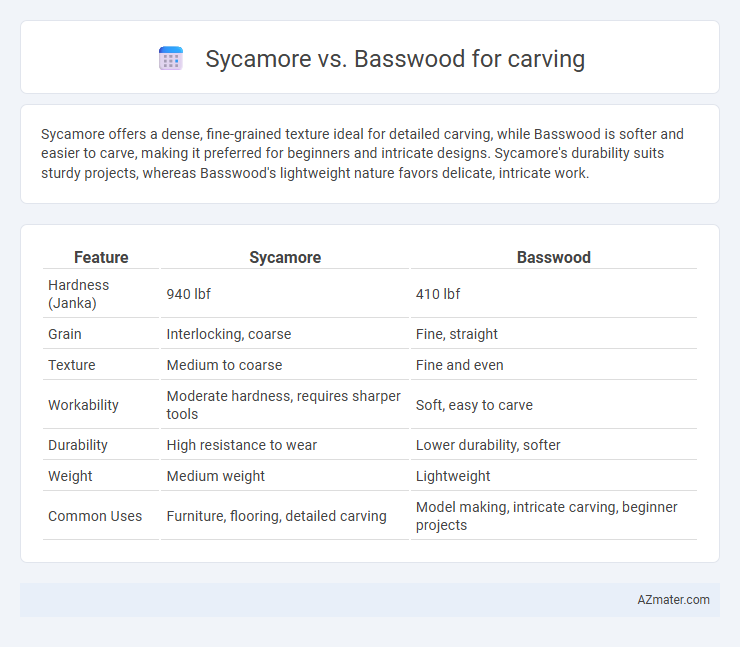Sycamore offers a dense, fine-grained texture ideal for detailed carving, while Basswood is softer and easier to carve, making it preferred for beginners and intricate designs. Sycamore's durability suits sturdy projects, whereas Basswood's lightweight nature favors delicate, intricate work.
Table of Comparison
| Feature | Sycamore | Basswood |
|---|---|---|
| Hardness (Janka) | 940 lbf | 410 lbf |
| Grain | Interlocking, coarse | Fine, straight |
| Texture | Medium to coarse | Fine and even |
| Workability | Moderate hardness, requires sharper tools | Soft, easy to carve |
| Durability | High resistance to wear | Lower durability, softer |
| Weight | Medium weight | Lightweight |
| Common Uses | Furniture, flooring, detailed carving | Model making, intricate carving, beginner projects |
Introduction to Sycamore and Basswood for Carving
Sycamore and basswood are popular hardwoods chosen for carving due to their unique grain patterns and workability. Sycamore features a distinctive interlocking grain that offers durability and a visually striking finish, while basswood is prized for its fine, even texture and softness, making it easier to shape and ideal for detailed work. Both woods provide excellent surface smoothness, but basswood's lightweight and minimal grain make it particularly favored by beginners and intricate carvers.
Wood Characteristics: Sycamore vs Basswood
Sycamore wood features a coarse, interlocking grain with a medium hardness of about 950 on the Janka scale, providing durability and a distinct, mottled appearance ideal for textured carving projects. Basswood is softer, rating around 410 on the Janka scale, with a fine, uniform grain and pale color, making it one of the easiest woods for detailed, intricate carving and minimal tool resistance. The dense, harder sycamore offers better wear resistance, while the lighter, softer basswood ensures smooth cuts and finer detail retention.
Workability and Carving Ease
Sycamore offers a fine, even grain that provides excellent workability and precise detail retention, making it favored for intricate carving projects. Basswood is softer and more pliable, allowing easy cutting and fewer tool marks, ideal for beginners or quick carving tasks. Both woods carve cleanly, but basswood excels in ease of shaping, while sycamore supports durability and finer finishes.
Grain Structure and Texture Comparison
Sycamore features a fine, interlocking grain with a uniform texture that offers excellent detail retention and smooth carving surfaces, making it ideal for intricate designs. Basswood has a straight, even grain and a soft, fine texture that is easy to carve and ideal for beginners, but it may lack the durability and detail sharpness of sycamore. The dense grain of sycamore provides more resistance to wear and tool marks, while basswood's softer fibers allow for faster shaping but less defined edges.
Durability and Longevity in Finished Carvings
Sycamore wood offers moderate durability with a fine, tight grain that resists splitting, making it suitable for detailed carvings that maintain structural integrity over time. Basswood, known for its softness and uniform texture, is less durable but easier to carve, often requiring sealing or finishing treatments to enhance longevity in finished pieces. For long-lasting carvings subjected to wear, sycamore generally provides superior durability, while basswood excels in projects prioritizing ease of carving over extended lifespan.
Detailing and Finishing Capabilities
Sycamore offers a unique texture with tight grain that allows for finer detailing and smoother finishes in carving projects. Basswood, known for its softness and uniform grain, excels in capturing intricate detail with less effort, making it ideal for beginners and detailed fine work. While sycamore's density provides durability and sharp edges after finishing, basswood's ease of sanding and paint adhesion ensures a versatile finishing experience.
Availability and Cost Differences
Sycamore is widely available in North America and Europe, often offering a middle-range cost due to its moderate growth rate and demand in woodworking. Basswood, highly favored by carvers for its soft texture and fine grain, tends to be more affordable and easier to source, especially in the United States. The cost difference generally reflects basswood's abundance and ease of carving, making it the preferred choice for beginners and hobbyists compared to the slightly pricier and denser sycamore.
Best Applications for Each Wood Type
Sycamore offers a fine, even grain that makes it ideal for detailed carving, especially in creating intricate designs and smooth finishes on decorative items and utensils. Basswood, known for its soft texture and minimal grain, is preferred by beginners and professionals for relief carving, chip carving, and intricate patterns requiring delicate cuts. While sycamore excels in durability and strength suitable for functional objects, basswood's ease of carving makes it perfect for prototypes, toys, and lightweight sculptures.
Pros and Cons: Sycamore vs Basswood
Sycamore offers a dense grain and durability, making it ideal for detailed carving and projects requiring strength, while its hardness can pose challenges for beginners. Basswood is softer and easier to carve, favored for smooth finishes and fine detailing, but its softness may lead to less structural durability in finished pieces. Both woods have distinct textures and workability that influence their suitability depending on the intricacy and longevity of the carving project.
Conclusion: Choosing the Right Wood for Your Project
Sycamore offers a dense grain and durability ideal for detailed carving requiring strength and fine finishes. Basswood's soft texture and consistent grain make it perfect for beginners and projects needing smooth, easily carved surfaces. Selecting between sycamore and basswood depends on the desired carving detail, tool ease, and finished texture for your specific artistic vision.

Infographic: Sycamore vs Basswood for Carving
 azmater.com
azmater.com